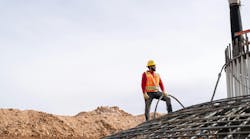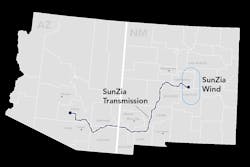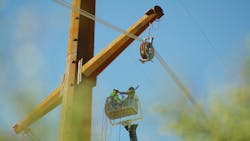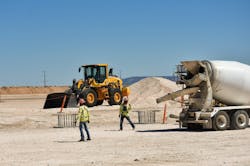Reducing greenhouse gas emissions and combating the climate crisis is requiring communities around the world to rethink how they generate their electricity. Of course, this is the great energy transition, and it involves moving away from traditional fossil fuel-based generation and toward renewable sources of energy. And, it is happening across the U.S. From offshore wind farms in the Northeast to solar developments in California as well as new hydrogen hubs popping up throughout the country, the onboarding of new renewable energy projects is encouraging to see.
However, generating renewable energy is only half the battle. These kinds of projects also require a significant amount of grid infrastructure, as utilities must be able to deliver the energy. Many sources of renewable energy can only be produced in certain geographic locations. Generating solar power requires plentiful sunlight. Hydropower relies on bountiful water resources. And wind power needs, well, a lot of wind. But what about the regions that do not have those characteristics? They need renewable energy sources, too.
That is why T&D infrastructure is so important and why more grid modernization projects are happening around the country. Case in point: The purpose of the SunZia transmission project is to deliver renewable energy from wind farms in New Mexico to communities in Arizona followed by California. It is part of the largest clean energy infrastructure initiative in U.S. history and can serve as an example for future grid modernization projects.
A Brief History
The state of New Mexico boasts some of the most abundant, constant wind in the U.S. As of 2022, the state generated approximately 4000 MW of wind power — about 30% of New Mexico’s total energy generation. New Mexico has the potential to produce much more wind power, but it lacks the transmission infrastructure needed to deliver the electricity to consumers in other locations. That is where the SunZia transmission project comes into play.
The SunZia project is part of a larger initiative driven by Pattern Energy Group LP. It is enabling Pattern to develop an approximately 3500-MW wind farm in the state of New Mexico by providing the transmission infrastructure to deliver this energy where it is needed. The project will help to reduce reliance on fossil fuels and provide communities with low-cost, reliable, carbon-free energy.
The SunZia transmission project had been discussed in the U.S. for several years. In May 2023, the U.S. Department of the Interior (DOI) announced its decision, and construction was allowed to commence. As per the DOI, the project “represents another milestone in the Biden-Harris administration’s efforts to accelerate transmission buildout to lower consumers’ energy costs, prevent power outages in the face of extreme weather, create good-paying union jobs, and make progress towards achieving President Biden’s goal of a 100% clean electricity grid by 2035.”
The SunZia wind farms are being built southeast of Albuquerque, New Mexico, in the counties of Lincoln, Torrance and San Miguel. The energy generated there will be delivered across 12 counties — via the SunZia transmission project — to Arizona, just southeast of Phoenix, in Pinal County. It is an approximately 550-mile (885-km) long transmission system that traverses federal, state and private lands to reach its destination. From there, it is distributed to communities in Arizona or sent on to California.
Projects like SunZia are massive endeavors that require significant planning and investment. They also depend on robust collaboration, new and innovative technologies, and community partnerships.
Leveraging HVDC
One of the biggest trends with renewable energy integration projects is the increasing use of high-voltage direct-current (HVDC) power transmission. This is because HVDC transmission can transmit large amounts of power over long distances more reliably and affordably than alternating-current transmission. It is perfect for projects like SunZia and can deliver wind power from the middle of New Mexico where production is plentiful to communities in the Southwest where it is not.
HVDC transmission acts almost like a pipeline, sending large amounts of electricity from where it is produced over long distances down the line for use. Using traditional high-voltage alternating-current (HVAC) transmission lines on this project would be less cost-effective over the life of the project, as 550 miles is a great distance and HVAC transmission lines do not offer the same effectiveness at such distances as HVDC.
Another innovative aspect of SunZia, the project combines multiple proven technologies in a unique way. For example, when the project goes into service, it will be one of the highest-capacity HVDC voltage source converter (VSC) systems in operation in the world. At ±525 kV and 3000 MW, the SunZia transmission project will raise the ceiling on long-distance high-voltage VSC transmission.
The project is also one of the few VSC HVDC overhead transmission line projects in the world. A VSC converts the electrical power generated by the wind turbines from alternating current to direct current. Up until now, VSCs were only typically used for transmission underwater by way of submarine cables. However, SunZia uses VSC converters with overhead line transmission, and this combination will enable SunZia to transmit larger amounts of power over a long distance in a reliable, cost-effective way.
SunZia also uses alternating-current (ac) choppers to allow wind farms to ride through disturbances affecting the HVDC transmission system. Traditionally, islanded wind farms connected by HVDC submarine cables have used direct-current (dc) choppers to protect the dc system and provide fault ride-through capability to the wind turbines. However, ac choppers enable high-speed fault clearing on the dc transmission line as well as the receiving-end ac system, providing improved system reliability.
The SunZia project can serve as a great example of embracing new technologies and methods. The electric utility industry can expect these innovations to continue evolving, so it is important to stay aware of developments within the transmission industry.
Community Partnerships
Establishing relationships with local stakeholders and nearby communities was foundational to developing SunZia. This is typically true with any project, but it is even more so when designing infrastructure that spans 12 counties, multiple states, and federal, state and private lands.
What does this mean? Firstly, thoughtful and proactive engagement. Stakeholders must feel engaged, and the project needs to solicit input, consider concerns, and incorporate feedback in the planning and development process. This can come in the form of in-person community meetings, online communications, stakeholder surveys and general communication of facts to project stakeholders. The SunZia project spans several communities with unique input, so taking this into account in the project design was key.
One of the key messages of the SunZia project was the opportunity for good-paying, local jobs in the region. Just as it was communicated by the Biden-Harris administration, the team at SunZia had to outline how local stakeholders could benefit from increased job activity in the region. Another key message was highlighting how the project would be completed with respect for the environment. Again, this project spans over 550 miles. It was incredibly important and necessary to demonstrate strong environmental stewardship across the entire transmission line, including paralleling existing infrastructure, when possible. The project also benefited from the support of the National Audubon Society, which believes SunZia serves as a case study for how a project can be designed to avoid the worst impacts to birds.
Design and construction are only a couple aspects of grid modernization projects. It also takes strong community partnerships and robust stakeholder engagement to make the local communities part of the overall vision.
Grid Modernization
The race to renewable energy is on — and it looks to be staying that way as utilities strive to reach the ambitious decarbonization targets. To achieve these goals, utilities must be able to deliver renewable energy to the communities that need it. The energy transition will not happen overnight; it will take decades of planning and trillions of dollars in investment to make that dream a reality. And, modernizing the electrical infrastructure will play a significant role in these net-zero efforts.
Massive endeavors like the SunZia transmission project can help utilities to modernize the grid and drive the energy transition forward. These projects will rely on industry experts from around the world coming together to derive solutions that may not have existed before. They will also demand robust partnerships, innovative technology, new methodologies and strong stakeholder engagement.
However, projects like SunZia demonstrate that these kinds of grid modernization efforts are achievable, and they can help deliver renewable energy to communities around the world. Heading forward, more projects like SunZia need to be developed. The energy transition demands it.







